
Lower Merion Township is a township in Montgomery County, Pennsylvania and part of the Philadelphia Main Line. As of the 2016 U.S. Census, the township had a total population of 58,288. Lower Merion has the 5th highest per-capita income and the 12th highest median household income in the country with a population of 50,000 or more.

Westmorland is a historic county in north-west England. It formed an administrative county between 1889 and 1974, after which the whole county was administered by the new administrative county of Cumbria. In 2013, the Secretary of State for Communities and Local Government, Eric Pickles, formally recognised and acknowledged the continued existence of England's 39 historic counties, including Westmorland.

The Sweet Auburn Historic District is a historic African-American neighborhood along and surrounding Auburn Avenue, east of downtown Atlanta, Georgia, United States. The name Sweet Auburn was coined by John Wesley Dobbs, referring to the "richest Negro street in the world," one of the largest concentrations of African-American businesses in the United States. A National Historic Landmark District was designated in 1976, covering 19 acres (7.7 ha) of the neighborhood, significant for its history and development as a segregated area under the state's Jim Crow laws.

Uptown Charlotte is the central business district of Charlotte, North Carolina. The area is split into four wards by the intersection of Trade and Tryon Streets, and bordered by Interstate 277 and Interstate 77. Uptown Charlotte is the largest business district in Charlotte and the Carolinas.

Fourth Ward is one of the historic six wards of Houston, Texas, United States. The Fourth Ward is located inside the 610 Loop directly west of and adjacent to Downtown Houston. The Fourth Ward is the site of Freedmen's Town, which was a post-U.S. Civil War community of African-Americans.
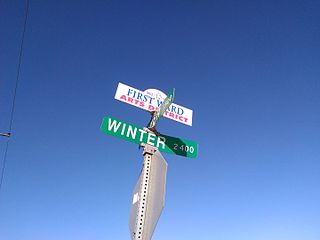
The First Ward of Houston, which is located inside the 610 Loop, is one of the city's historic wards. It was originally the center of the business district for the city, and was strategically located at the intersection of Buffalo Bayou and White Oak Bayou, near an area now known as Allen's Landing. It was one of the original four wards in Houston when it was created in 1840. It was defined as all area within the city limits of Houston north of Congress Street and west of Main Street.

The Old Fourth Ward, often abbreviated O4W, is an intown neighborhood on the eastside of Atlanta, Georgia, United States. The neighborhood is best known as the location of the Martin Luther King, Jr. historic site.
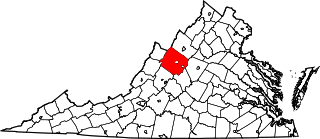
This is a list of the National Register of Historic Places listings in Augusta County, Virginia.

This is a list of the National Register of Historic Places listings in Madison County, Virginia.

The Sixth Ward is a community in Houston, Texas, United States.
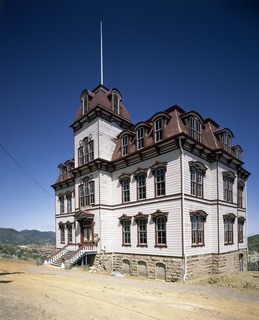
The Fourth Ward School is an historic 4-story mansard-roofed former public school building located at 537 South "C" Street in Virginia City, Nevada. Designed in 1876 by architect C. M. Bennett in the Second Empire style of architecture, it originally held over 1000 students in grades 1 though 9 divided into three departments: primary (grades 1 though 4); second grammar and high school. Grades 10 through 12 were added by 1909. It graduated its last class in 1936, after which its students were moved to a new school built by the Works Progress Administration.
Fourth Ward School may refer to:

Antioch Missionary Baptist Church is a historic Baptist church at 313 Robin Street in Downtown Houston, Texas. It was historically a part of the Fourth Ward. As of 2012 it was the only remaining piece of the original Fourth Ward east of Interstate 45.
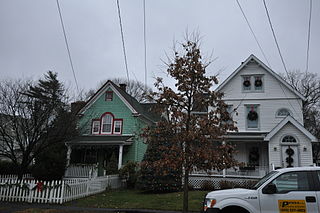
The Fourth Ward Historic District encompasses an early urban residential subdivision of Greenwich, Connecticut. Extending north from United States Route 1 along Sherwood Place, Church Street, and adjacent streets, it is one of two subdivisions created before the arrival of the railroad in Greenwich in 1848. It is characterized by dense residential construction, with architectural styles from the Greek Revival to early 20th-century styles. The district was listed on the National Register of Historic Places in 2000.

Historic Fourth Ward Park is a park built on the site of the old Ponce de Leon amusement park, in the Old Fourth Ward of Atlanta, just south of Ponce City Market and just west of the BeltLine trail.
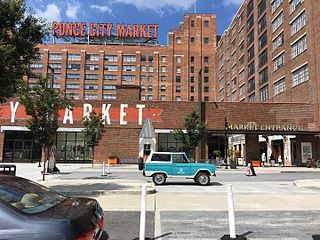
Eastside refers to the city district comprising the easternmost portion of Atlanta, Georgia, United States. The Eastside generally encompasses the area bounded on the west by Midtown Atlanta and Downtown Atlanta and on the east by the city limits. The central corridor of the district is the BeltLine Eastside Trail, which connects northern Eastside neighborhoods with those to the south. The Eastside is known for its nightlife establishments, craftsman architecture, local eateries, and quirky public art.

The Old Fourth Ward Southeast Historic District is a nationally recognized historic district located in Waverly, Iowa, United States. It was listed on the National Register of Historic Places in 2013. At the time of its nomination it contained 137 resources, which included 87 contributing buildings, and 50 non-contributing buildings. The historic district is a residential area immediately to the south of the Waverly East Bremer Avenue Commercial Historic District, and within the bend of the Cedar River. The primary resources in the district are all houses, and the secondary resources are either carriage houses or garages. All but four houses contribute to the historical significance of the district, but a majority of the secondary resources do not.

The Fourth Ward Historic District is a historic district in Albuquerque, New Mexico which encompasses an area between Downtown and Old Town which is roughly bounded by Central Avenue, 8th Street and Keleher Avenue, Lomas Boulevard, and 15th Street. It is named for its location in the city's former fourth political ward. The district is almost entirely residential and developed at a "leisurely pace" between the 1880s and 1930s. As a result, it includes houses in a wide variety of sizes and styles including Queen Anne, Italianate, Tudor, Dutch Colonial, Prairie School, Mediterranean, Pueblo, Territorial, Mission, and Bungalow. The district was added to the New Mexico State Register of Cultural Properties in 1979 and the National Register of Historic Places in 1980.
















